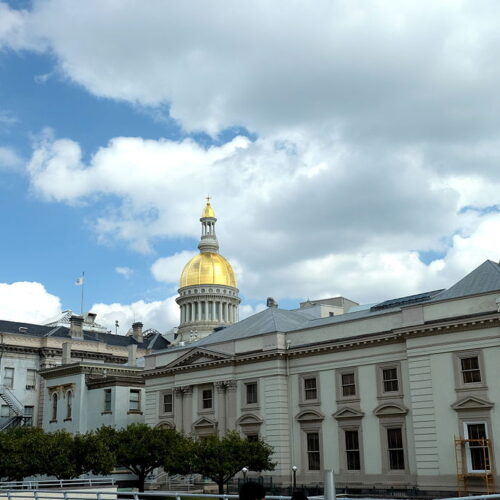
The Path to Statewide Community Crisis Response in New Jersey: A Community Advocate’s Perspective

Mr. Gantry Fox
The Seabrooks-Washington Community-Led Crisis Response Act, signed into law by New Jersey Governor Phil Murphy in January 2024, is intended to tackle key issues about public safety responses that have long been championed by members of the community. As one of the first states to enact such legislation, New Jersey is leading the charge in creating statewide response models that address mental health crises.
However, the effort to enact this legislation didn’t begin with state officials. It started at the grassroots level, often led by a coalition of mental health professionals, law enforcement officials, and community advocates. One group that was critical to these efforts was Salvation and Social Justice, a faith-based nonprofit in Trenton, NJ, which conducted a series of public hearings in cities across the state to document the experiences of Black communities when dealing with the police. These collective accounts were used to spark a larger conversation around policing in the state, which was highlighted even further after the shootings of Najee Seabrooks and Andrew Washington in 2023.
Back in 2021, Gantry Fox, director of Operations at Salvation and Social Justice, facilitated a conversation about community response in New Jersey that is featured in The Council of State Governments (CSG) Justice Center’s Expanding First Response toolkit. With the passage of New Jersey Seabrooks-Washington Community-Led Crisis Response Act, the CSG Justice Center spoke with Mr. Fox again to learn more about his path, from working in communities to understand the impact of policing practices to working across the state to reimagine crisis response.
Editor’s note: Answers have been edited for length and clarity.
You have led initiatives that seek to empower communities through collective action for years. So, why was it important for you and Salvation and Social Justice to be involved in the movement toward getting the Seabrooks-Washington Community-Led Crisis Response Act passed?
Our involvement regarding racial disparities and injustices within the criminal justice system stems directly from the oppression of Black people since our ancestors touched this continent’s soil. In New Jersey, we have a long history with unjust policing and discriminatory behavior, whether it’s the bias that spawned the Newark Riots of 1967, the pervasive prejudicial traffic stops throughout the 1980’s and 1990’s that earned our state police a consent decree, or the cruel police responses that lead to physical, emotional, psychological, and financial harms. This includes the deaths of Andrew Washington, Najee Seabrooks, and others.
In 2018, NJ Advanced Media released The Force Report, which provided evidence to what so many Black New Jersian households had known: that there were significant racial disparities in use of force practices predominantly against Black people. But growing up in South Jersey, I had my own experiences that ignited my passion for putting community safety in the hands of the community, too.
That made me personally, and us organizationally, inspired to help advance legislation that would allow our communities to have a stake in leading, creating, and overseeing alternative forms of public safety responses. Our involvement lends itself to our broader mission on creating a more equitable and just society where systemic inequalities are addressed through a combination of advocacy, education, and community engagement.
How did you and others at Salvation and Social Justice engage and involve the community in advocating for this legislation?
Community engagement is paramount in our work. This stems back to our founding and when we held “Use of Force” hearings throughout the state in 2019 to hear the stories of people who were victimized by officers and the legal system. These hearings led us to facilitating cohorts in North and South Jersey to walk beside these communities as they reimagined what public safety should and could look like. From those meetings, it was clear that communities wanted a true stake in public safety solutions in their own neighborhoods and had the resources to do it. They wanted the ability to be part of the public safety process by having a role in developing, executing, and overseeing these solutions. So, we worked closely with state advocates, policy experts, and research institutions to ensure that happened.
We held campaigns, public workshops, executed social media and communication strategies, developed a toolkit for faith leaders to use, held police accountability-centered events, met in churches, and even created our Trenton Restorative Street Team, an example of a community-led solution to violence interruption in the city of Trenton.
It was important to us to have families and survivors of the people impacted by police violence weigh-in on these policy conversations, and that meant making sure the lawmakers heard from them directly. Ensuring those voices were amplified was an essential part of advancing this bill.
What were some key moments that contributed to the legislation being passed, and why was it important for Salvation and Social Justice to be active in these efforts?
The successful passing of the Seabrooks-Washington Community-Led Crisis Response Act was the result of an amalgamation of preparedness, steadfast work on the part of advocates, public pressure, and a series of tragedies and current events. We had long been working with our advocate partners engaging in legislative outreach and education regarding community-led alternative models throughout the nation that included op-eds, virtual events, and in-person community events.
Tragically during this time, however, a series of instances resulted in the killing of unarmed, Black New Jersey residents by police. Those killings only further supported advocate and community demands for the need to have community-led alternatives. Additionally, a series of reports from the Attorney General’s office, as well as the New Jersey Comptroller’s Office, provided further evidence of the systemic issues within law enforcement.
What impact do you hope the legislation and its mandates will have on the community?
This new legislation is a major initiative that aims to create a more humane and effective way of responding to mental health and substance use crises. It involves a reduction in reliance on police and emergency services for nonviolent situations that require mental health or addiction support, and it’s going to empower community members who can take charge of their well-being and safety, because they will be provided with the resources and training needed to handle crises in a compassionate and culturally appropriate way.
Most importantly, I believe this bill will protect our community. I see it as an important step toward rectifying historical injustices in New Jersey and ensuring that the principles of democracy are upheld for everyone.
To learn more about the efforts that helped lead to the successful passing of the Seabrooks-Washington Community-Led Crisis Response Act, read Three Things to Know About New Jersey’s Groundbreaking Community Responder Legislation.
Photo Credit: All photos provided courtesy of Salvation and Social Justice
ABOUT THE AUTHOR

In response to growing calls for police reform in New Jersey, particularly following the shootings of Najee Seabrooks…
Read More Three Things to Know About New Jersey’s Groundbreaking Community Response Legislation
Three Things to Know About New Jersey’s Groundbreaking Community Response Legislation
In response to growing calls for police reform in New Jersey, particularly following the shootings of Najee Seabrooks and Andrew Washington in March and August 2023, a coalition of law enforcement officials, mental health professionals, and community advocates partnered to explore public safety response alternatives.
Read More Apply Now: Join a Learning Community for Community and Crisis Response Teams to Improve Responses to Youth
Read More
Apply Now: Join a Learning Community for Community and Crisis Response Teams to Improve Responses to Youth
Read More
 Apply Now: Join a Learning Community Focused on Substance Use and Overdose Community Response Programs
Read More
Apply Now: Join a Learning Community Focused on Substance Use and Overdose Community Response Programs
Read More
 Apply Now: Join the 2024-2025 Learning Community on Community Violence Intervention Programs
Read More
Apply Now: Join the 2024-2025 Learning Community on Community Violence Intervention Programs
Read More
 Developing a Common Definition for Community Responder Programs
Developing a Common Definition for Community Responder Programs
This May, the state of Washington passed legislation supporting the expansion of alternative response teams (sometimes called community responders) as a public safety service.
Read More










